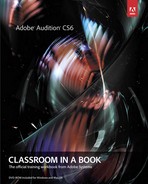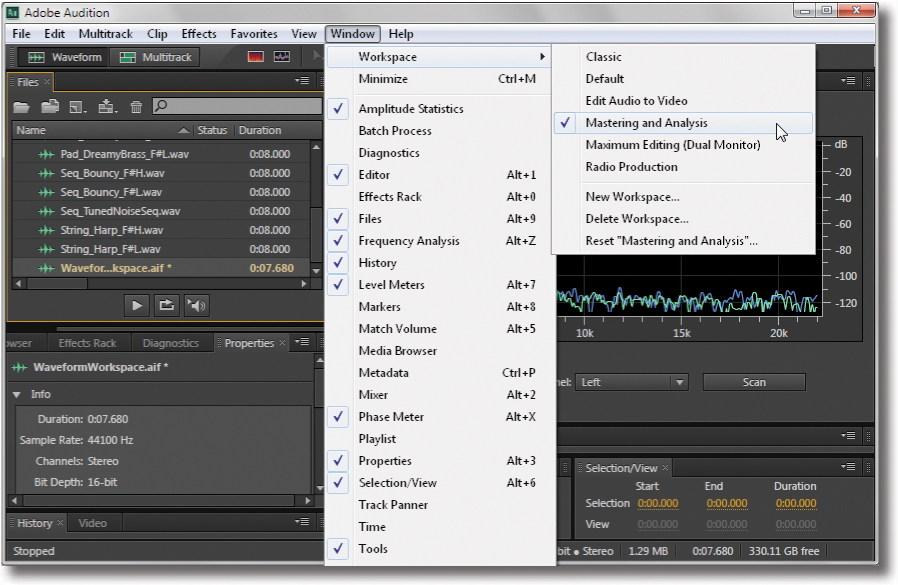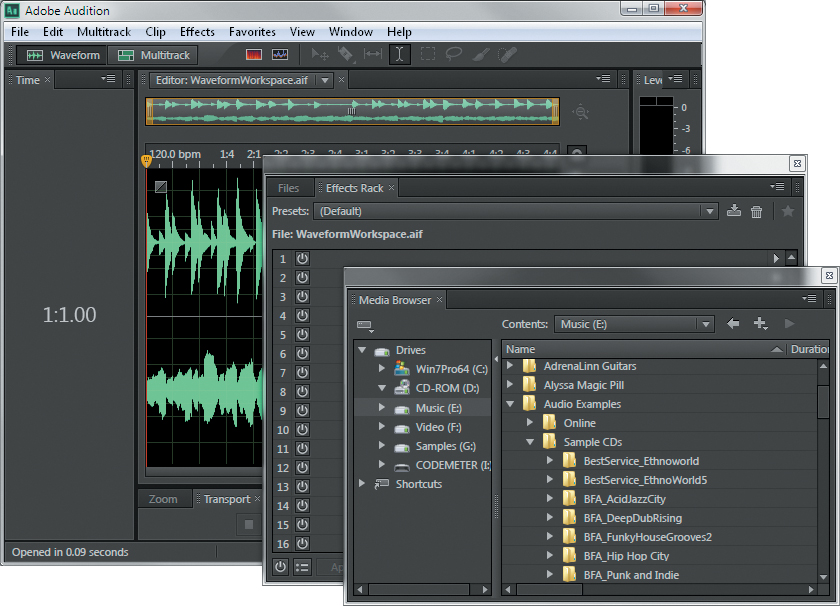2. The Audition Environment
You can create custom workspaces with particular selections of windows and window arrangements, as well as choose various ways to navigate through Audition’s Waveform Editor and Multitrack Editor.
Audition’s dual personality
A unique aspect of Audition is that it combines the functionality of two programs within a single piece of software:
• A Waveform Editor that can perform highly detailed and sophisticated editing
• A Multitrack Editor for creating multitrack music productions
In addition, the two sections are interrelated in that audio can move freely between the two environments. Audio in the Multitrack Editor can be transferred to the Waveform Editor for detailed editing and then transferred back. Files brought into the Waveform Editor can be tweaked prior to making them the basis of a multitrack project.
Both editors have highly customizable workspaces that you can optimize for any of Audition’s uses—not just editing or multitrack productions but also audio for video, sound library development, audio restoration, sound effects creation, and even forensics. This lesson concentrates on the Waveform Editor, but operations in the Multitrack Editor are similar, and in many cases, identical.
The Audition Workspace
Audition’s Workspace, which is consistent with other Adobe video and graphics applications so you needn’t learn multiple user interfaces, consists of multiple windows. You choose which windows make up a workspace, and you can add or remove them at any time. For example, you don’t need a video window if you’re not doing an audio-for-video project, but you’ll need it if you’re creating a soundtrack. Or, when you’re creating a multitrack project, you may need the Media Browser open to locate files you want to use, but when mixing, you can close the Media Browser to create space for inserting other windows. You can also save a particular window setup as a workspace.
Once windows are brought into a workspace, they are arranged as frames and panels.
Frames and panels
Frames and panels are the main elements in a workspace, and you can rearrange them to suit your particular needs.
1. With Audition open, navigate to the Lesson02 folder, and open the file WaveformWorkspace.aif.
2. Choose Window > Workspace > Classic.
3. To make sure the workspace uses the stored version, choose Window > Workspace > Reset Classic.

Note
When you open Audition, it opens to the last workspace you were using. You can modify a workspace as much as you want, but always revert to the original version you created (as described later) by choosing Window > Workspace > Reset [name of workspace].
4. A dialog box asks if you want to reset Classic to its original layout. Click Yes.
5. Click on the waveform, which is within the waveform’s Editor panel. When you click in a panel, a yellow line outlines the panel.
6. If you want to see more of the waveform’s Editor panel, click the panel’s left yellow line, and drag to the left to widen the panel.
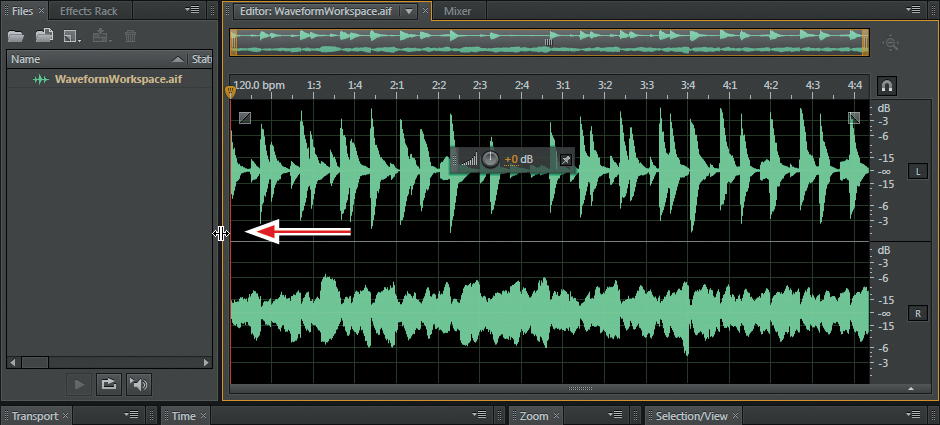
Note
Panels can have divider lines at the top, bottom, right, and/or left. If a divider icon appears when you hover over one of these lines, you can click and drag to resize the panel. You can also resize the entire workspace by clicking on any edge and dragging.
7. Increase the panel’s height by clicking the panel’s lower line and dragging down. However, this may cause the panels below the waveform to disappear or become narrow enough to be unusable. So, return the panel’s lower line to where it was, and then start to customize the workspace.
Every panel has a tab toward the top of it. The right part of the tab has a Close box, which closes the panel (you can always reopen a panel from the Window menu if you need it later).
8. The Selection/View panel probably isn’t needed right now, so click its Close box to open up some more space. Note how the Zoom panel expands to take up the space.
Every panel is housed in a frame. You can save space by grouping several panels into the same frame to create a collection of panels that has tabs across the top for bringing a particular panel to the “front” of the frame.
9. On the left part of a panel’s tab is a gripper; click the Time panel’s gripper and drag it next to the Zoom panel’s tab. A strip containing this tab turns blue to indicate it is a “drop zone” where a panel can be dropped.

10. Release the mouse button; the Time and Zoom panels are now within a tabbed frame.
Note
With narrow frames containing multiple tabs, a tab’s Close box may not be visible. You can close tabs via a frame’s drop-down menu, which is accessible toward the frame’s upper-right corner.
11. Click the Transport panel’s gripper, and drag it into the blue drop zone strip that already has the Zoom and Time tabs. Now the Zoom, Transport, and Time panels are all within a tabbed frame.

12. Click the Zoom tab, then the Time tab, and then the Transport tab. Note that the original double rows of buttons are now single rows, which allows more space for increasing the Editor panel height.
Note
You can click and drag on a tab to change its position among the other tabs.
13. With the Transport tab showing, click in the Editor panel. Click its lower yellow line and drag down until the Transport panel is just high enough to show all the buttons. Click the Time tab and then the Zoom tab, and note that they’ve also been resized to fit.
Note
There are three green drop zones on the left, right, bottom, and top edges of the Audition Workspace. These are different from the blue drop zones because anything dropped into these green drop zones will extend to the main window’s full length or height.
14. To create even more space, move the Levels panel to the left of the Audition Workspace. Click the Levels panel gripper, and drag it to the Audition Workspace’s left edge.
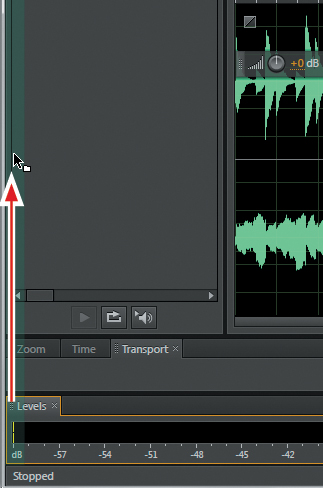
15. Now you can drag the bottom of the Editor panel down even further.
Adding a new panel
So far, you’ve rearranged existing panels within a workspace. However, you can also add a new panel to a frame.
1. Currently, the Files and Effects Rack panels are in a single frame. This would be a convenient frame for placing the Media Browser panel, so add it to the frame.
2. Click a panel in this frame, like Files.
3. Choose Window > Media Browser. The Media Browser is added to the frame.
However, note that the frame is narrower and you can no longer see all three tabs. When this happens, Audition adds a scroll bar just above the frame.

4. Click the scroll bar and drag left and right to reveal the various tabs.
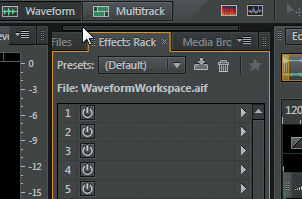
Note
If your mouse has a scroll wheel, you can also hover over any frame tab and scroll from tab to tab using the mouse scroll wheel.
Dragging panels and frames into panel drop zones
When you click a gripper and drag a panel over another panel, blue “drop zones” appear that indicate where the panel can be dropped. There are five main drop zones.
If the panel drop zone is in the panel center, dropping a panel there is equivalent to dropping it into the bar with the tabs. However, if the panel drop zone shows a bar with beveled edges, the frame will land where the bar is and push the panel with the bar over to make room.
The frame with the Media Browser, Effects Rack, and Files seems unnecessarily tall, and the space at the bottom isn’t really necessary. That would be a good place to drag the Time panel.
1. Click the Time panel gripper, and drag it toward the Effects Rack. As it passes over the bottom of the Effects Rack panel, you’ll see a blue bar with beveled edges.

You can also drag frames into drop zones; the frame gripper is in the frame’s upper-right corner. Suppose you decide you’d rather have the Time panel above the frame with the Media Browser, Effects Rack, and Files panels. You could drag the Time panel into the frame’s upper beveled bar, but there’s another way. Neither option is inherently superior, but you might prefer one workflow over the other.
2. Click the frame’s gripper, and drag it into the Time panel’s lower bar.

The Frame drop-down menu
Every frame has a drop-down menu in the upper-right corner. This menu always contains at least five options:
• Undock Panel
• Undock Frame
• Close Panel (same as clicking a tab’s Close box)
• Close Frame
• Maximize Frame
There may also be options that relate to specific panels. For example, the Media Browser panel drop-down menu has options for Enable Auto-Play, Enable Loop Preview, and Show Preview Transport. This is handy because even if the Preview Transport isn’t shown, it’s still possible to enable its Auto-Play and Loop Preview functions.
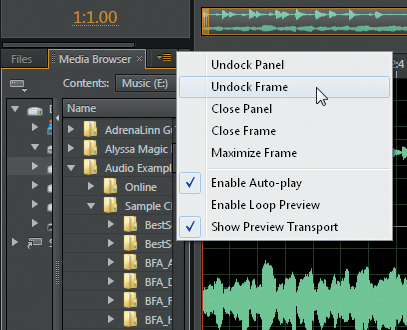
Undocking allows you to “float” a panel or frame outside of the main window. Here’s how it works.
1. Click the drop-down menu for the frame containing the Media Browser, Files, and Effects Rack panels.
Note
You can undock a frame or panel by clicking its gripper and dragging the gripper outside the Audition Workspace.
2. Choose Undock Frame.
The frame becomes a separate window that can be moved independently of the Audition Workspace and resized.
3. Click the Media Browser panel.
Note
After undocking frames or panels, they will still have grippers that you can use to re-dock them as you would any other frame or panel.
4. Click the drop-down menu of the frame containing the Media Browser panel.
5. Choose Undock Panel. Now there are three separate windows—the Audition Workspace, the frame with the Files and Effects Rack panels, and the Media Browser panel.
Tools panel
The Tools panel has some unique attributes compared to the other panels.
1. The Tools panel defaults to being a toolbar—a thin strip of buttons along the top of the Audition Workspace—and has no drop-down menu. Undock it by clicking the gripper in the upper-left corner and dragging it outside the Audition Workspace.
Note
The Status Bar at the bottom of the workspace is the one element that is permanent and cannot be floated or docked (however, you can choose whether to show or hide it by choosing View > Status Bar > Show). The Status Bar shows statistics about file size, bit resolution, sample rate, duration, available disk space, and the like.
When undocked, the toolbar takes on the characteristics of a panel: It’s housed within a frame, can be combined with other panels within the frame, and contains a frame drop-down menu. It also includes two extra fields—a drop-down menu for choosing a workspace that duplicates the Window > Workspace path and a search box.
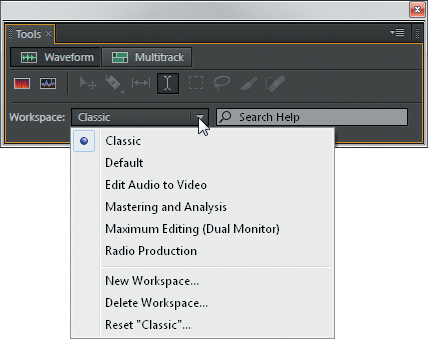
2. Re-dock the toolbar along the top of the Audition Workspace before proceeding, and then close Audition.
Create and save custom workspaces
You are not limited to the workspaces that are included with Audition and can create you own.
1. Arrange the workspace exactly as desired.
2. Choose Window > Workspace > New Workspace.
3. Name the workspace by typing a name into the New Workspace dialog box, and then click OK. Your workspace now joins the list of current workspaces.
4. To delete a workspace, choose Window > Workspace and select a workspace other than the one you want to delete.
5. Choose Window > Workspace > Delete Workspace.
6. When the Delete Workspace dialog box appears, choose the workspace you want to delete from the drop-down menu, and then click OK.
Navigation
There are three main elements to navigation:
• Navigating to desired files and projects so you can open them, typically using Audition’s Media Browser
• Navigation related to playing back and recording audio within the Waveform Editor and Multitrack Editor
• Navigating visually within the Waveform Editor and Multitrack Editor (zooming in and out to specific parts of the file)
Navigating to files and projects
For both Mac and Windows, Audition adopts standard navigation menu protocols (such as Open and Open Recent) for navigating within the computer to find specific files and projects. The only significant departure is the Open Append menu option, which relates mostly to the Waveform Editor.
1. Open Audition, navigate to the Lesson02 folder, and open the file WaveformWorkspace.aif.
2. Choose File > Open Append > To Current.
3. Navigate to the Lesson02 folder, choose String_Harp.wav, and in the dialog box, click Open.
4. The file you selected is appended to the end of the current waveform in the Waveform Editor.
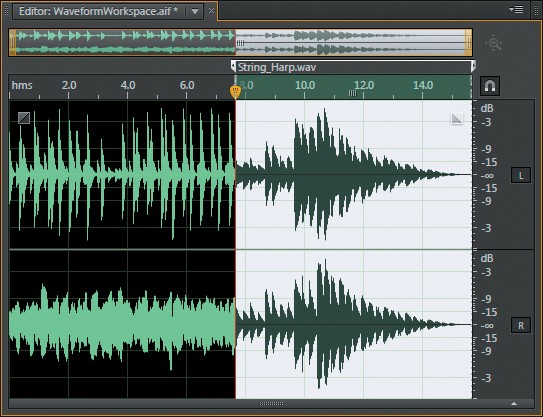
5. Choose File > Open Append > To New.
6. Navigate to the Lesson02 folder, choose String_Harp.wav, and open it.
7. The file you selected is opened in a new Waveform Editor view. It does not replace the previously loaded file, and you can select either one with the Editor panel’s drop-down menu.

Note
You can choose Open Append > To New in the Multitrack Editor; however, this will simply open the file in the Waveform Editor, not the Multitrack Editor.
8. Choose File > Close All, but leave Audition open in preparation for the next lesson.
Navigating with the Media Browser
The Media Browser is an enhanced version of the browsing options offered in the Windows and Macintosh operating systems. If you use Windows, it works similarly to the standard Windows Explorer. If you use the Mac, the Media Browser resembles the list view browser in the left column, but selecting a folder in the left column opens its contents in the right column, like the Mac Finder’s column view.
Once you locate a file, you can drag it into the Waveform Editor or Multitrack Editor window.
1. Choose Window > Workspace > Default.
2. Choose Window > Workspace > Reset Default. Click Yes when the confirmation dialog box appears.
3. Click the Media Browser’s gripper and drag it outside of the workspace to float it. This isn’t strictly necessary, but this makes it easy to extend the size to see all the available options in the Media Browser. Drag the window to the right to extend it.
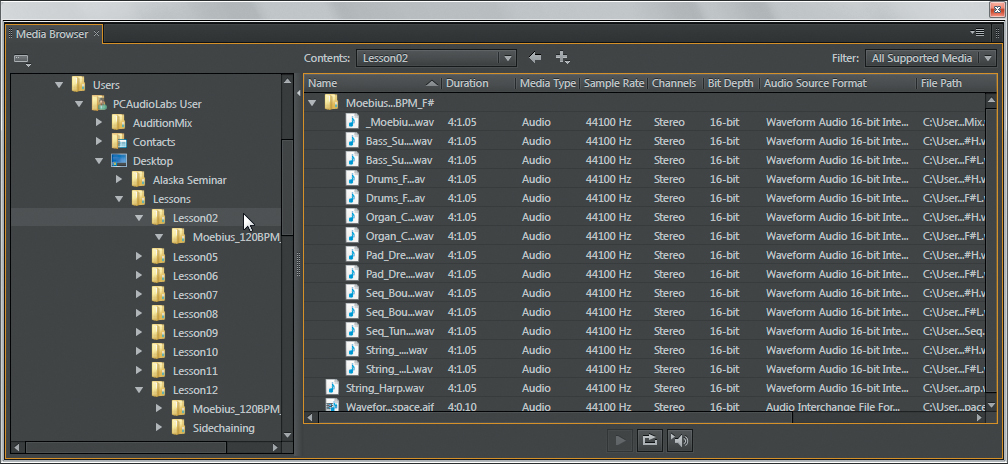
4. The left Media Browser column shows all the drives mounted to your computer. Clicking on any of these displays its contents in the right column. You can also click a drive’s disclosure triangle to reveal its contents.
Tip
The Locations drop-down menu in the upper left, above the list of your computer’s drives, lets you select any drive. Its contents appear immediately in the right column.
5. In the left column, navigate to the Lesson02 folder. Click its disclosure triangle to expand it, and then click the Moebius_120BPM_F# folder.
The folder’s audio files are shown in the right column. Note how additional subcolumns show file attributes, such as duration, sample rate, channels, and more.
6. You can change subcolumn widths. Click the divider line between two subcolumns, and drag left or right to change width.
7. You can rearrange the order of subcolumns. Click a column name, like Media Type. Drag it left or right to position it. This feature is helpful because you can drag the columns containing the information you need the most to the left side, so the data is visible even if the window isn’t fully extended to the right.
8. For providing single-click access to specific folders, the Media Browser offers a “virtual drive” along with the other computer drives in the left column that contains shortcuts for often-used folders. To create a shortcut for the Moebius_120BPM_F# folder, click it in the left column.
9. In the right column, click the + symbol and choose Add Shortcut for “Moebius_120BPM_F#.”

10. Look in the left column, and click the Shortcuts disclosure triangle. Your shortcut now provides one-click access to the designated folder.
11. Another Media Browser advantage is that you can listen to the files as you browse, thanks to the Preview Transport. If it’s not visible, select Show Preview Transport from the upper-right drop-down menu. Click the Auto-Play button with the speaker icon, and you’ll hear a file play when you click it.
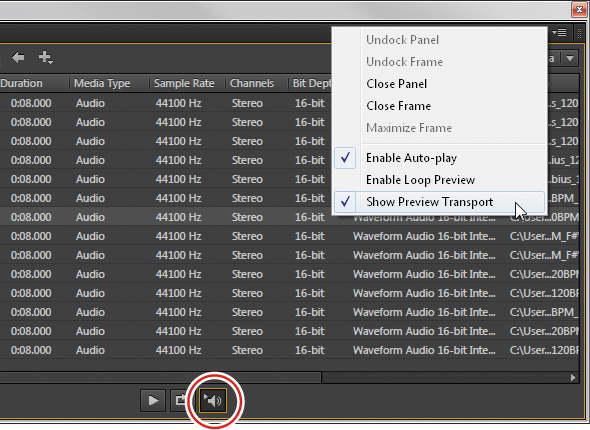
Note
If enabled, the Loop Playback button to the left of the Auto-Play button will cause the file to play back until you either choose another file or click the Stop button to the left of the Loop Playback button. If you don’t want Auto-Play but want to play files manually, deselect Auto-Play and click the Play button (which toggles with the Stop button) to start playback.
12. Close Audition without saving anything.
Navigating within files and Sessions
Once you’re in the Waveform Editor or Multitrack Editor, you’ll want to be able to navigate within the Editor to locate or edit specific sections. Audition has several tools that you can use to do this.
1. Open Audition, navigate to the Lesson02 folder, and open the file WaveformWorkspace.aif.
2. Click the Editor window’s gripper and drag it outside of the workspace to float the window.
3. Click the Workspace’s lower-left corner and drag diagonally down toward the right until you can see all the Transport and Zoom buttons. Then click around a third of the way into the waveform and drag to about two-thirds of the way through the waveform to create a selection. The orange icon at the beginning of the selection is called the current time indicator (CTI), or playhead in previous versions of Audition.
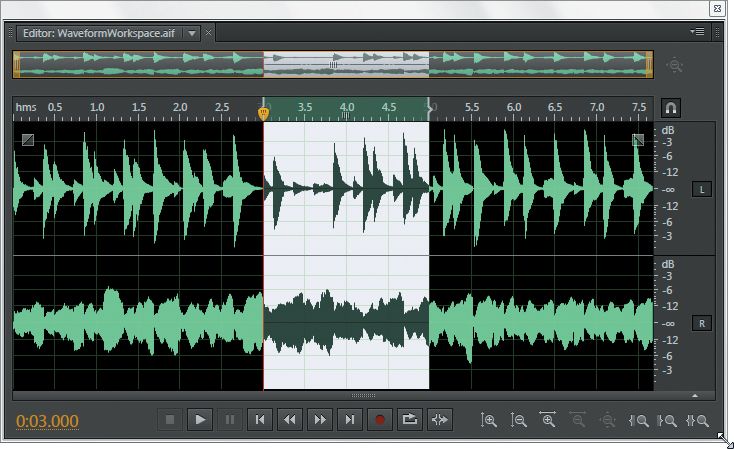
Navigation via zooming
Zooming acts the same way it does with a camera: Zoom out to see more of an object, and zoom in to see more detail. The Waveform Editor includes zoom buttons, but you can also open a Zoom panel with these same eight buttons if you want to position them elsewhere or float them. The Multitrack Editor includes these same zoom buttons.
1. The Zoom toolbar consists of eight buttons that control zooming. Click two times on the leftmost Zoom In (Amplitude) button. Zooming in on amplitude lets you see low-level signals more easily.

2. Click twice on the next button to the right, the Zoom Out (Amplitude) button. This returns you to the previous amplitude zoom level.
Note
If you zoom in all the way using Zoom In (Time), you can see—as well as edit—the individual samples that make up the waveform.
3. Click eight times on the next button to the right, the Zoom In (Time) button. This lets you see very short sections of time on the waveform.
4. Click twice on the next button to the right, the Zoom Out (Time) button. This lets you zoom back out.
5. Click once on the next button to the right, the Zoom Out Full (All Axes) button. This is a “shortcut” button that zooms out the time and amplitude axes to maximum so you can see the complete waveform.
6. Click the next button to the right, the Zoom In at In Point button. This places the selection start (In point) in the middle of the waveform.
7. Click the next button to the right, the Zoom In at Out Point button. This places the selection end (Out point) in the middle of the waveform.
8. Click the rightmost button, the Zoom to Selection button. This causes the selection to fill the window.
9. Click the Zoom Out Full button (the third from the right) to return both axes to zoomed out full.
10. There’s an additional Zoom tool at the top of the window that shows a global view of your audio file. Drag the left or right side of the yellow grabber to zoom in or out of an area; the area between the two yellow grabbers is what you’ll see in the Editor. Note that you can click the grabber in the middle of the two yellow bars to move the zoom area left or right.

11. To reset the zoom back to the see the entire audio waveform, click the Zoom Out Full button to the right of the upper zoom tool. Close Audition without saving anything.
Navigation with markers
You can place markers (also called cues) within the Waveform Editor and Multitrack Editor to indicate specific places you want to navigate to immediately. For example, in a Multitrack project, you might place markers before a verse and chorus so you can jump back and forth between them. In the Waveform Editor, you might place markers to indicate places where edits are required.
1. Open Audition, navigate to the Lesson02 folder, and open the file WaveformWorkspace.aif.
Note
You can rename a marker by right-clicking (Control-clicking) on its white handle in the Waveform Editor and choosing Rename Marker. Or you can click on the marker name in the Markers panel, click again after a slight pause (you don’t want to double-click), and then type in a new name. Renaming with either method renames both instances of the marker.
2. Choose Window > Workspace > Reset “Default.” Click Yes to confirm.
3. Choose Window > Markers. The Marker panel appears.
4. Click in the waveform toward the beginning, around 1.0 second.
5. Press M. This adds a marker at the playhead (CTI) location and adds the marker to the list of markers in the marker window.
6. Now click in the waveform around 3.0 seconds. As an alternate way to add a marker, click the Add Cue Marker button in the Markers panel.
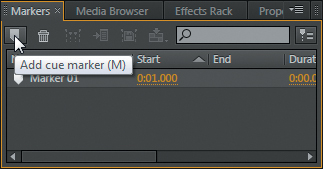
7. You can also mark a selection. Click around 5.0 and drag right to 6.0 to create a selection. Press M to mark the selection. Note that the Markers panel shows a different symbol to indicate this Range marker is marking a selection.
8. You can also convert the Range markers to an individual marker at the selection start. Right-click (Control-click) on either the start or end of the Range marker, and then choose Convert to Point.
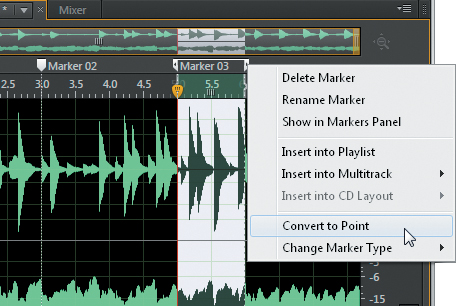
9. There are several ways to navigate among markers. Double-click the first marker in the Markers panel list, and the playhead jumps to that marker. Double-click the last marker in the Marker panels list, and the playhead jumps to the last marker.
10. Another method for marker navigation involves the Transport. We’ll talk about that next. Leave Audition open in preparation for the next lesson.
Navigation with the Transport
The Transport offers several navigation options, including navigation using markers.
1. Click the Move Playhead to Previous button. The playhead moves to Marker 2.
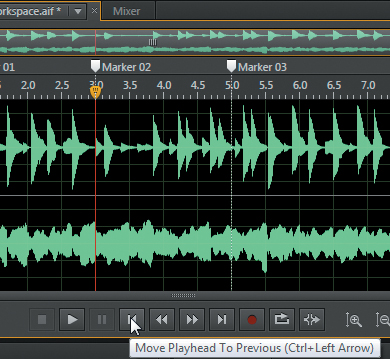
Note
If a file contains no markers, Move Playhead to Next jumps to the end; Move Playhead to Previous jumps to the beginning. In the Multitrack Editor, clip start and end points are automatically considered markers by the Transport’s Move Playhead to Next and Move Playhead to Previous buttons.
2. Click the Move Playhead to Previous button again. The playhead moves to Marker 1. Click the Move Playhead to Previous button once more, and the playhead moves to the beginning of the file.
3. Click the Move Playhead to Next button (the button to the left of the Record button with the red dot) four times. The playhead steps to each marker until it reaches the end of the file.
4. To move the playhead backward in the file without dragging the playhead or using markers, click and hold the Rewind button until the playhead is in the desired location. You’ll hear audio during the scrolling process. Rewind back to the beginning.
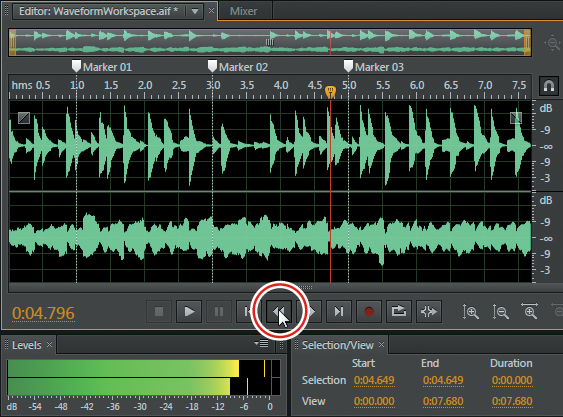
Note
The Fast Forward button to the right of the Rewind button works similarly to the Rewind button but moves the playhead forward in the file. Note that you can right-click (Control-click) on either button to set the speed with which it moves.
5. Click the Play button (the second Transport button from the left with the right arrow). Playback begins.
Note
The Rewind, Fast Forward, Move Playhead To Next, Move Playback to Previous, and of course Stop can all be invoked during playback.
6. As soon as the playhead passes the first marker, click the Move Playhead To Next Button. The playhead jumps to the second marker. Click the Move Playhead To Next button again, and the playhead jumps to the third marker.
7. Right-click (Control-click) the Transport Play button and choose Return Playhead to Start Position on Stop. With this option selected, clicking Stop will return the playhead to where it started. With this option deselected, the playhead will stop at the position it had when you clicked the Stop button.
Review questions
1. What is the difference between a frame and a panel?
2. What is a drop zone?
3. What is a “floated” window?
4. In addition to locating files, name two major advantages of using the Media Browser.
5. What is the purpose of a marker?
Review answers
1. A frame contains one or more panels.
2. A drop zone indicates where a panel or frame will dock when it’s dragged to that zone.
3. A floated window exists outside of an Audition Workspace and can be dragged anywhere on your screen.
4. You can listen to the files you locate, as well as see attributes about them.
5. A marker indicates a place in a file or Session that the playhead can jump to immediately, thus speeding up navigation.
